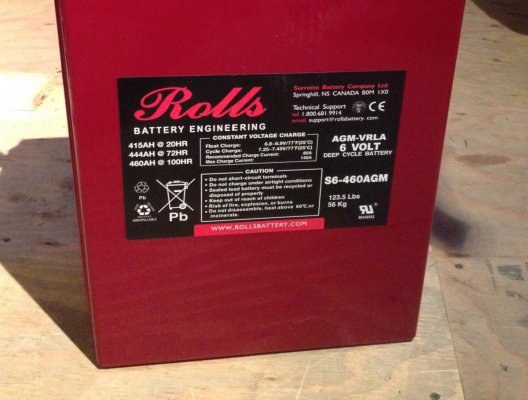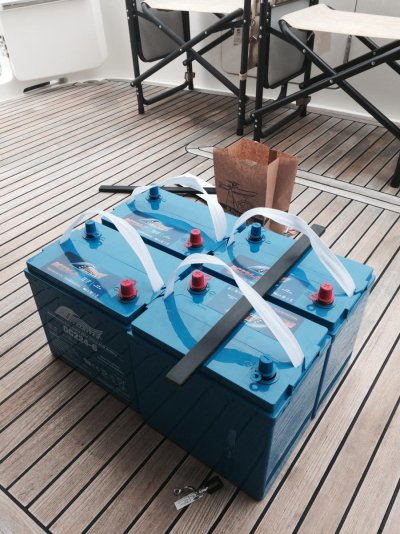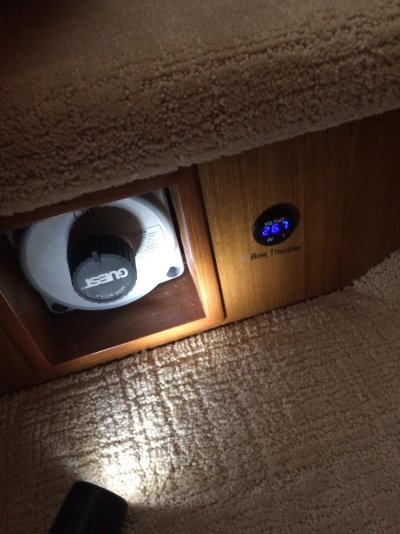I replaced the flooded cell batteries on my boat when they failed in 2012. I chose AGMs because properly maintaining the flooded cell batteries was very difficult because of their location in my boat.
I used Sears Die Hard Marine AGMs and they have performed reasonably well. especially considering that they were run down flat a couple times, but they seem to be nearing the end of their life. Anchoring overnight with the refrigerator, Chart Plotter and (LED) anchor light on, the voltage in the morning is 12 volts or less.
A thread on another forum mentioned "Lifeline" (brand) AGM batteries as being the "best" AGMs and of course their website claims the same. Surprisingly, they don't seem to be more expensive than the Sears batteries or West Marine batteries.
So, before I spend $1,200 or so on a set of (4) new batteries, does anyone here have experience with these batteries? Good, bad or indifferent?
Depending upon when you bought your Die Hard AGM's they may have actually been re-branded EnerSys / Odyssey TPPL AGM's. The Sears/Odyssey product usually had a light blue bottom of case & gray/whiteish top of case.
These were a true
premium AGM battery at a very decent price. They actually cost less than my wholesale cost of an Odyssey but they sat too long on the shelf at our local Sears to bother with and were usually not "
fresh" up here.
Today, due to the premium price tag of the Odyssey/EnerSys product, Sears has gone back to East Penn for AGM's. If you go with Sears AGM batteries again don't expect comparable life to your EnerSys made TPPL AGM's.
For PSOC use see the:
Fighting Sulfation In AGM's - Practical Sailor May 2015
And
AGM Batteries Test Update - Practical Sailor August 2015
Brief points from the above linked testing...
- A) All batteries were treated exactly the same using lab grade test equipment and a temp controlled water-bath.
- B) They were discharged and charged as we often do on boats thus replicating real world use in a "lab like" environment for closer A to B comparisons.
- PSOC "capacity walk-down" begins as early as cycle #2 away from a full recharge.
- The Firefly Carbon Foam battery was the only AGM battery to survive the testing and recover all of its capacity. Other than the Lithium battery, which was used as a control or benchmark (unaffected by PSOC use), the Firefly came out on top. PS's caution as "new technology" is certainly within reason, and I agree with it. The PSOC data and abuse I have thrown at these batteries, still speaks rather strongly for the Firefly as a potential game changer for PSOC applications on cruising boats. Firefly has had a few manufacturing glitches, and supply/demand issues, but the battery technology is actually quite impressive at dealing with PSOC (partial state of charge) use. It is really the only 80% DOD lead acid battery I know of that can actually survive this sort of deep cycling in the real world not just in a lab..
- The way we use batteries on cruising boats is murder to them. Having a battery than can recover from the effects of sulfation could be a real game changer and far less complicated than LiFePO4.
- In just 30 cycles some of the AGM batteries lost between 7% and 30% of their total baseline tested Ah capacity.. Just 30 cycles....

 In the real world those 30 cycles would have likely been even more punishing, especially in a hot climate. The Northstar Blue+ TPPL AGM, Odyssey TPPL AGM and Lifeline AGM all did okay in the testing but none as good as the Firefly. The East Penn data is what it is and it was the only battery in the test group that got a second chance.
In the real world those 30 cycles would have likely been even more punishing, especially in a hot climate. The Northstar Blue+ TPPL AGM, Odyssey TPPL AGM and Lifeline AGM all did okay in the testing but none as good as the Firefly. The East Penn data is what it is and it was the only battery in the test group that got a second chance.
After performing many, many, many hundreds of hours of battery testing I believe pretty strongly that that a typical deep cycle AGM battery (not all AGM's are actually deep cycle despite what the sticker may say) really need to get back to 100% SOC every 2nd or 3rd cycle for the
best performance and
longest cycle life. Ideally
every cycle but that is simply not realistic unless you're in a lab
It should be noted that the effects of sulfation happen to
all lead acid batteries, not just AGM. AGM batteries are just much easier to test and to show how we are
murdering our banks by how we use and abuse them..
The Firefly, we know, can go 30 deep cycles, with full recovery, but I suspect a full recharge ever 7-15 days is more reasonable for that battery.


 In the real world those 30 cycles would have likely been even more punishing, especially in a hot climate. The Northstar Blue+ TPPL AGM, Odyssey TPPL AGM and Lifeline AGM all did okay in the testing but none as good as the Firefly. The East Penn data is what it is and it was the only battery in the test group that got a second chance.
In the real world those 30 cycles would have likely been even more punishing, especially in a hot climate. The Northstar Blue+ TPPL AGM, Odyssey TPPL AGM and Lifeline AGM all did okay in the testing but none as good as the Firefly. The East Penn data is what it is and it was the only battery in the test group that got a second chance.


